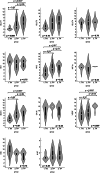[18F]FDG Uptake and Expression of Immunohistochemical Markers Related to Glycolysis, Hypoxia, and Proliferation in Indeterminate Thyroid Nodules
- PMID: 36253663
- PMCID: PMC10172288
- DOI: 10.1007/s11307-022-01776-4
[18F]FDG Uptake and Expression of Immunohistochemical Markers Related to Glycolysis, Hypoxia, and Proliferation in Indeterminate Thyroid Nodules
Abstract
Purpose: The current study explored the association between 2-[18F]fluoro-2-deoxy-D-glucose ([18F]FDG) uptake and the quantitative expression of immunohistochemical markers related to glucose metabolism, hypoxia, and cell proliferation in benign and malignant thyroid nodules of indeterminate cytology.
Procedures: Using a case-control design, 24 patients were selected from participants of a randomized controlled multicenter trial (NCT02208544) in which [18F]FDG-PET/CT and thyroid surgery were performed for Bethesda III and IV nodules. Three equally sized groups of [18F]FDG-positive malignant, [18F]FDG-positive benign, and [18F]FDG-negative benign nodules were included. Immunohistochemical staining was performed for glucose transporters (GLUT) 1, 3, and 4; hexokinases (HK) 1 and 2; hypoxia-inducible factor-1 alpha (HIF1α; monocarboxylate transporter 4 (MCT4); carbonic anhydrase IX (CA-IX); vascular endothelial growth factor (VEGF); sodium-iodide symporter (NIS); and Ki-67. Marker expression was scored using an immunoreactive score. Unsupervised cluster analysis was performed. The immunoreactive score was correlated to the maximum and peak standardized uptake values (SUVmax, SUVpeak) and SUVmax ratio (SUVmax of nodule/background SUVmax of contralateral, normal thyroid) of the [18F]FDG-PET/CT using the Spearman's rank correlation coefficient and compared between the three groups using Kruskal-Wallis tests.
Results: The expression of GLUT1, GLUT3, HK2, and MCT4 was strongly positively correlated with the SUVmax, SUVpeak, and SUVmax ratio. The expression of GLUT1 (p = 0.009), HK2 (p = 0.02), MCT4 (p = 0.01), and VEGF (p = 0.007) was statistically significantly different between [18F]FDG-positive benign nodules, [18F]FDG-positive thyroid carcinomas, and [18F]FDG-negative benign nodules. In both [18F]FDG-positive benign nodules and [18F]FDG-positive thyroid carcinomas, the expression of GLUT1, HK2, and MCT4 was increased as compared to [18F]FDG-negative benign nodules. VEGF expression was higher in [18F]FDG-positive thyroid carcinomas as compared to [18F]FDG-negative and [18F]FDG-positive benign nodules.
Conclusions: Our results suggest that [18F]FDG-positive benign thyroid nodules undergo changes in protein expression similar to those in thyroid carcinomas. To expand the understanding of the metabolic changes in benign and malignant thyroid nodules, further research is required, including correlation with underlying genetic alterations.
Keywords: Glucose Metabolism; Glycolysis; Immunohistochemistry; Thyroid Nodule; [18F]FDG-PET/CT.
© 2022. The Author(s).
Conflict of interest statement
The authors declare no competing interests.
Figures




References
Publication types
MeSH terms
Substances
LinkOut - more resources
Full Text Sources
Medical
Miscellaneous

